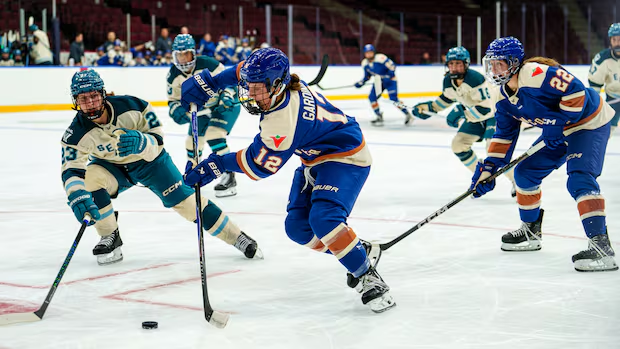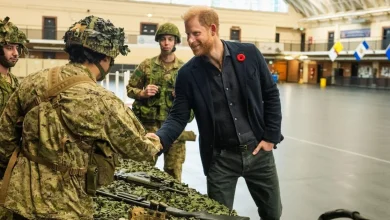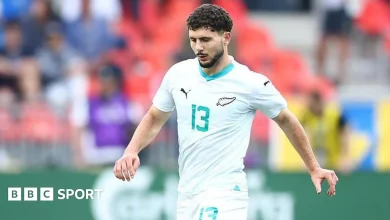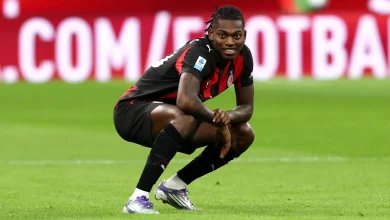5 things to watch as the PWHL’s 3rd season debuts on Friday

After a five-month off-season that featured rosters thrown in a blender and two new teams added to the mix, the PWHL’s third season will get underway on Friday.
Each team will play 30 regular-season games, with a lengthy break in the middle for the Milano-Cortina Olympics in February. The top four teams will make the Walter Cup playoffs. You can find a preview of each individual team here.
The league targeted the west coast for its first expansion, and the Vancouver Goldeneyes will host the Seattle Torrent for both teams’ first game on Friday night (7 p.m. PT/10 p.m. ET).
But it won’t stop there. Another two to four teams could come as early as next season, as the PWHL eyes a major U.S. broadcast deal.
WATCH | Everything you need to know about Vancouver’s PWHL team:
Here’s everything you need to know about Vancouver’s new PWHL team
The PWHL’s newest expansion team, the Vancouver Goldeneyes, are about to embark on their inaugural season in the league.
A busy first weekend is ahead: The third season begins with the reigning Walter Cup champions, the Minnesota Frost, hosting the Toronto Sceptres in a playoff rematch (7 p.m. ET) on Friday, followed by the Torrent at the Goldeneyes later that night.
Then, the Ottawa Charge will host the New York Sirens on Saturday (7 p.m. ET), and the Montreal Victoire will visit Boston on Sunday (1 p.m. ET).
Seventeen games this season will air on CBC and CBC Gem, beginning with a Nov. 29 matchup between the Toronto Sceptres and Boston Fleet (2 p.m. ET).
Here are five storylines to watch in the league’s third season:
How will the two expansion teams gel?
The Goldeneyes and Torrent emerged from the expansion draft process with a bevy of stars.
In Vancouver, goaltender Emerance Maschmeyer is looking to bounce back after an injury in Ottawa put the brakes on what had been a strong season. Supporting her from the blue line are three smart, puck-moving defenders: Sophie Jaques, Claire Thompson and Ashton Bell.
They’re joined by sophomore defender Sydney Bard and Mellissa Channell-Watkins, who played an underrated role in the Minnesota Frost’s past two championships.
Up front, they’re led by Sarah Nurse, who was one of the team’s first signings, hometown forward Jennifer Gardiner, and Finnish national team star, Michelle Karvinen. In free agency, Vancouver added a ton of star power at forward, including Hannah Miller, Michela Cava and Tereza Vanišová.
WATCH | Hockey North: Previewing the PWHL’s 8 teams:
What to expect from PWHL expansion teams Vancouver, Seattle
Host Karissa Donkin and The Athletic’s Hailey Salvian break down the rosters of the Professional Women’s Hockey League’s two newest teams.
There are also young forwards with room to grow, like Izzy Daniel, Abby Boreen and Brooke McQuigge, all of whom were drafted from original six teams.
That leaves Vancouver with a number of options as head coach Brian Idalski constructs his top six.
“I like our core group,” Idalski said. “I think that it’s just a matter of now putting together combinations that click and work, and hammering down on some of our structures and details in how we want to play.”
Meanwhile, Seattle boasts size and skill up front, and a shutdown mentality on its blue line. The Torrent has some of the league’s best shot blockers, including Mariah Keopple, Aneta Tejralová and Anna Wilgren.
“They were built on being physical, gritty,” Idalski said about his team’s first opponent.
Being able to roll out an all-Team USA top line of Hannah Bilka, Alex Carpenter and Hilary Knight, followed by Julia Gosling, Danielle Serdachny and Jessie Eldridge, should give Seattle a potent offence.
But the big challenge for the two new teams is that it can take time for players to build chemistry and adjust to new systems. Rosters were just finalized on Thursday after a two-week training camp, which means coaches still have plenty of work ahead.
It’s easy to say Vancouver and Seattle will finish the season atop the standings, but things don’t always translate from paper immediately.
One thing is clear, though: Vancouver and Seattle are already successful off the ice.
Amy Scheer, the league’s executive vice president of business operations, said earlier this week that Vancouver leads in the league in season ticket sales. Seattle is number three in season tickets, but set a new record for one-day jersey sales.
“They’ve quickly become two of our strongest markets and have set themselves up as examples on how to do this in the future,” Scheer said.
More teams coming
With another two to four teams joining the PWHL in the near future, the league is again scouting for new markets.
“Similar to last year, we will be talking to interested markets and going through the evaluation process, and when we feel the time is right and we’ve got the right partners, we’ll announce where we’re expanding,” Scheer said. “That process has been ongoing and will continue for the next several months until we ultimately come to a conclusion.”
WATCH | Ottawa Charge won’t play in smaller arena, PWHL says:
Ottawa Charge won’t play in smaller arena, PWHL says
The Professional Women’s Hockey League says a recently approved plan to redevelop parts of Lansdowne Park includes an arena that is too small for their fan base.
Part of that process will take place on the Takeover Tour, where the PWHL will stage neutral-site games in 11 different cities: Edmonton, Hamilton, Halifax, Quebec City, Winnipeg, Calgary, Dallas, Detroit, Denver, Chicago and Washington, D.C.
A handful of those cities will host more than one game, including Edmonton and Halifax. The league has now visited Edmonton, Denver and Quebec City for two consecutive seasons (and Detroit for three).
But Scheer was tight-lipped on which cities are at the top of the league’s evaluation list.
A few things to consider: the league may want to fill in some of the distance between Seattle and Vancouver and Minnesota on the map, especially as it targets a major U.S. broadcast rights deal in the future.
As much as location matters, so does infrastructure. One of the biggest selling points for Vancouver was having its own rink.
Roster shakeups
Each original six team surrendered four players to Seattle or Vancouver through the expansion draft process. Another chunk of players switched teams over the summer through trades or free agency.
The New York Sirens are completely revamped from last season, and are now built around a young core of Sarah Fillier, Casey O’Brien and Kristýna Kaltounková.
The Montreal Victoire will look significantly different too, having bolstered its depth and pulled off a big trade to bring in skilled pest, Abby Roque.
Abby Roque was one of the top additions to the Montreal Victoire over the off-season. (PWHL)
Even though some fans may be upset to see their favourites change teams, the league has maintained that it designed the expansion process the way it did to keep competitive balance throughout all eight teams.
“Each team still does have a core in place,” said Jayna Hefford, who is the PWHL’s executive vice president of hockey operations.
“The challenges in the expansion market might be more [around] it’s a new team, it’s a new building, it’s a new staff, so they’ll face challenges that maybe the other teams faced in year one. But ultimately, we really like the roster breakdown right now.”
An Olympic year
This season will be the first with the Olympics in the middle, which means the PWHL will hit pause for a few weeks.
It’s a welcome interruption, as the league sees the potential of new eyeballs that could come from watching women’s hockey on the biggest international stage.
In the past, women’s Olympic hockey has drawn huge viewership figures in both Canada and the U.S. But viewers wouldn’t know how to follow those players throughout the rest of the season.
That’s no longer the case, now that the PWHL is here.
The PWHL hopes to capitalize on the Olympic tournament next year to add more women’s hockey fans. (Josh Kim/PWHL)
“We are taking the Olympics very seriously as something that could most certainly help elevate our business,” Scheer said. “It will be our job to turn that casual fan who might be tuning in for the first time into a PWHL fan.”
For the top players, this year comes with a lot of hockey, as they balance their national team commitments with league play.
But the league has also offered a new stage for players to prove they should be on their national team. We’ve already seen PWHL performance help some players get an invite to the Canadian national team’s training camps.
Rule changes
The PWHL hasn’t been afraid to experiment.
In season one, there was the jailbreak rule, which sees a player freed from the penalty box if their team scores shorthanded.
Last season, it was the no escape rule, which prevents a penalized team from changing lines at the beginning of the power play. That rule change was aimed at increasing offence, and seemed to have the desired effect. Hefford said scoring on the power play was up by about three per cent.
This season’s rule changes aren’t quite as flashy, but will still impact the game. The league is eliminating coach’s challenges and requiring three goaltenders to be under contract.
As soon as a goaltender is injured and can’t play, she will immediately be replaced by the second goaltender on the playing roster. The third goaltender will be added to the bench “with full goalkeeper privileges” at that point.
The PWHL has also brought in hall of fame official Bill McCreary as the director of officiating, strategy and performance. He refereed more than 1,700 regular-season NHL games during his career.
He’ll be responsible for making sure the PWHL’s officiating is consistent, particularly when it comes to the added physicality that the league has become known for.
“We all know that officiating is an essential part of the success of our on-ice product,” Hefford said. “It defines the standard of play. It speaks to the integrity of competition and it contributes to the trust and confidence in our fans and our players.”





